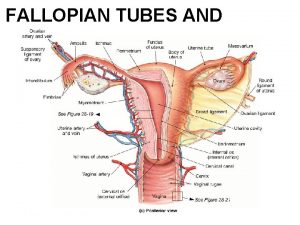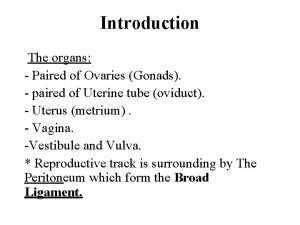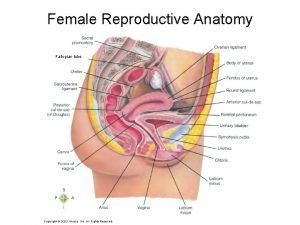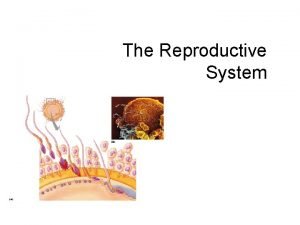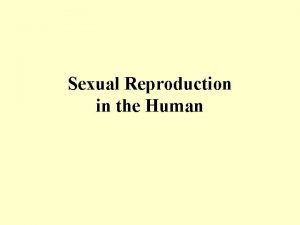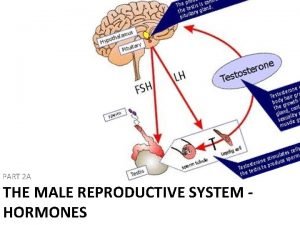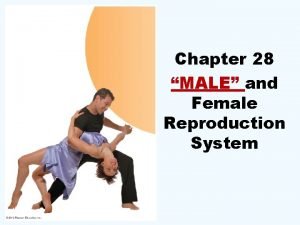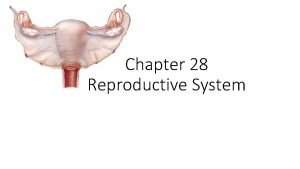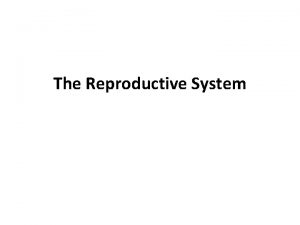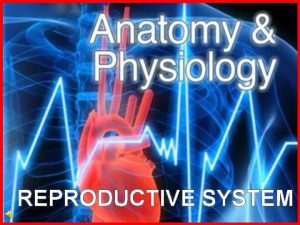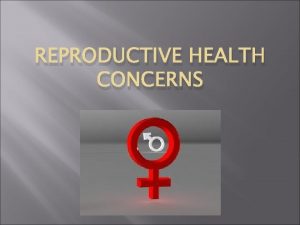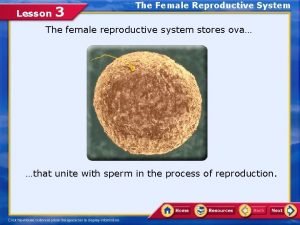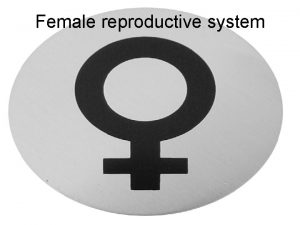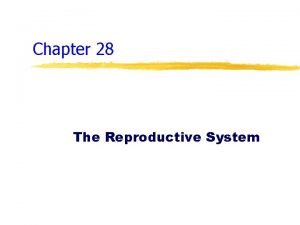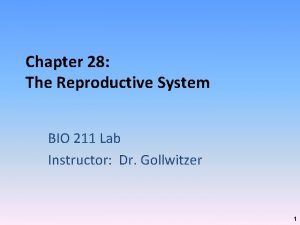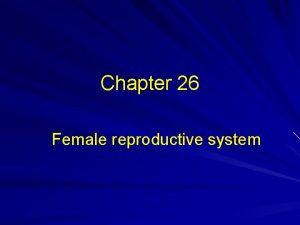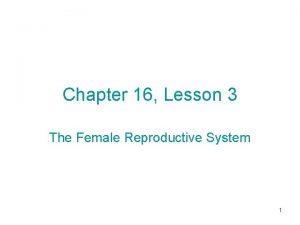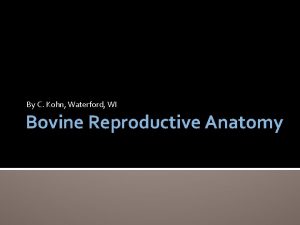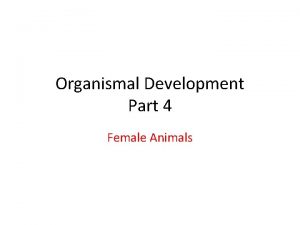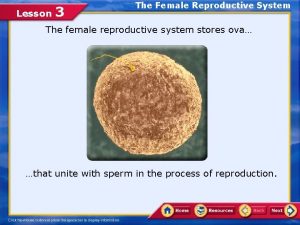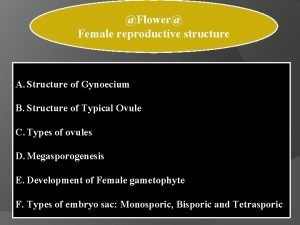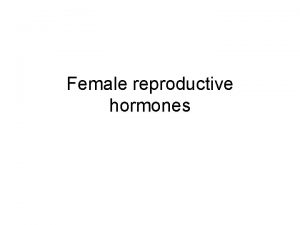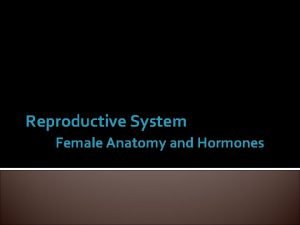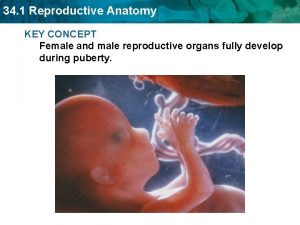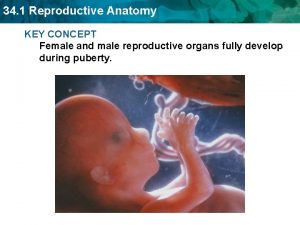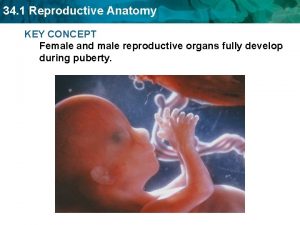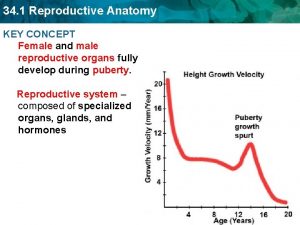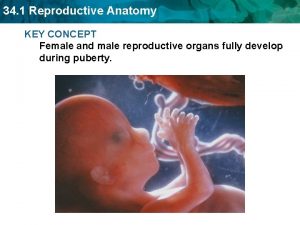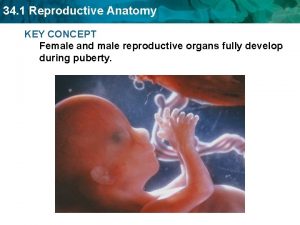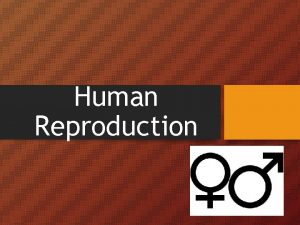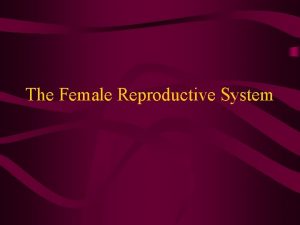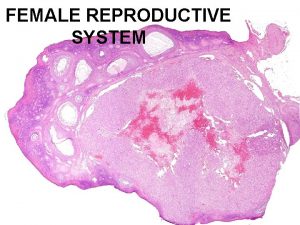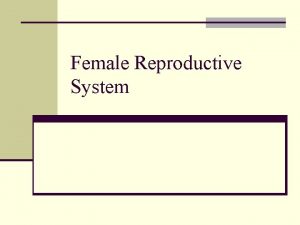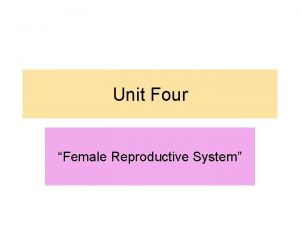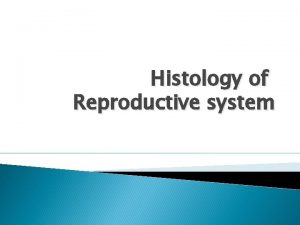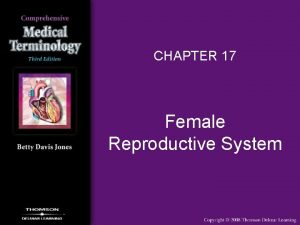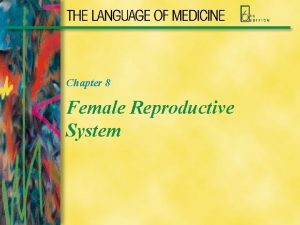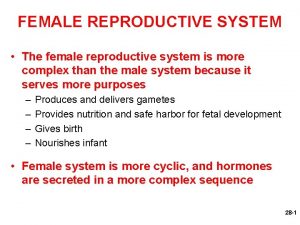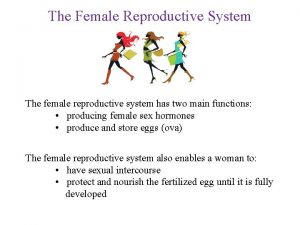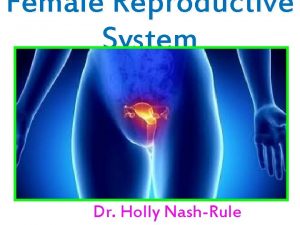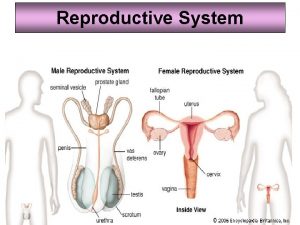34 1 Reproductive Anatomy KEY CONCEPT Female and































- Slides: 31

34. 1 Reproductive Anatomy KEY CONCEPT Female and male reproductive organs fully develop during puberty.

34. 1 Reproductive Anatomy The female reproductive system produces ova. • There are two main functions of the female reproductive system. – produce ova, or egg cells – provide a place where a zygote develops fallopian tube ovary uterus cervix pubic bone urinary bladder urethra rectum vagina

34. 1 Reproductive Anatomy • Estrogen has three main functions. – develop female sexual characteristics – develop eggs – prepare uterus for pregnancy

34. 1 Reproductive Anatomy The male reproductive system produces sperm. • There are two main functions of the male reproductive system. – produce sperm cells – deliver sperm to the female reproductive system urinary bladder seminal vesicle vas deferens pubic bone prostate gland rectum penis urethra epididymis scrotum testis bulbourethral gland

34. 1 Reproductive Anatomy • Testosterone has two main functions. – developing male sexual characteristics – producing sperm

34. 1 Reproductive Anatomy KEY CONCEPT 34. 2 Human reproductive processes depend on cycles of hormones.

34. 1 Reproductive Anatomy Eggs mature and are released according to hormonal cycles. • Follicle-stimulating hormone (FSH) and lutenizing hormone (LH) regulate egg production. – meiosis produces eggs and polar bodies – each egg has 23 chromosomes – meiosis is completed at fertilization potential egg Meiosis I Completed first polar body Meiosis II Completed only after sperm enters second polar body ovum (egg)

34. 1 Reproductive Anatomy • FSH, LH, and estrogen stimulate the release of eggs. – follicle ruptures at ovulation – egg travels into fallopian tube – ruptured follicle becomes corpus luteum fallopian tube uterus 5 to 7 days to uterus follicle egg cell egg released ovary uterine wall corpus luteum

34. 1 Reproductive Anatomy Eggs mature and are released according to hormonal cycles. • The menstrual cycle has three phases. – flow phase: endometrium sheds – follicular phase: ovulation occurs – luteal phase: corpus luteum forms

34. 1 Reproductive Anatomy • The menstrual cycle stops at menopause. – cycle continues until a woman’s mid-40’s or 50’s – decline in hormone levels make cycles irregular – eventually, cycle stops altogether

34. 1 Reproductive Anatomy Sperm production in the testes is controlled by hormones. • Testosterone, FSH, and LH stimulate sperm production. – one sex cell divides into four sperm – each sperm has 23 chromosomes potential sperm Meiosis II 4 sperm cells

34. 1 Reproductive Anatomy • Sperm cells fully mature in the epididymis. – head contains acrosome – midpiece contains ATP acrosome – tail allows mobility nucleus with 23 chromosomes head mitochondria midpiece tail

34. 1 Reproductive Anatomy Fertilization occurs when a sperm cell joins an egg cell. • Sperm penetrates an egg. – membrane keeps out other sperm – nucleus of sperm joins with egg – zygote formed

34. 1 Reproductive Anatomy • Multiple zygotes can result from fertilization. – identical twins from the same egg – fraternal twins from two separate eggs • Infertility makes reproduction difficult or impossible.

34. 1 Reproductive Anatomy Sexually transmitted diseases affect fertility and overall health. • Sexually transmitted diseases (STDs) are passed from one person to another during sexual contact. – bacterial STDs include chlamydia, syphilis, gonorrhea – viral STDs include hepatitis B, genital herpes, human papillomavirus, and HIV

34. 1 Reproductive Anatomy • Bacterial STDs can be treated, and in many cases, cured with antibiotics • Viral STDs can be treated, but there is no cure for these diseases. • STDs attack reproductive organs. – can cause infertility – untreated, some can be fatal • STDs can be avoided by A parasite causes trichomoniasis, which can abstinence or by using a affect fertility. condom.

34. 1 Reproductive Anatomy KEY CONCEPT 34. 3 Development progresses in stages from zygote to fetus.

34. 1 Reproductive Anatomy The fertilized egg implants into the uterus and is nourished by the placenta and umbilical cord. • The zygote becomes a blastocyst and implants in the uterus. – ectoderm develops into skin and nervous system – mesoderm develops into Internal tissues and organs – endoderm develops into digestive organs and their lining blastocyst uterine wall Implantation of blastocyst

34. 1 Reproductive Anatomy • The blastocyst becomes an embryo. • Embryonic membranes protect and nourish the embryo. – amniotic sac cushions embryo. – placenta connects placenta mother and embryo. umbilical – umbilical cord connects embryo to uterus placenta. amniotic sac

34. 1 Reproductive Anatomy A zygote develops into a fully formed fetus in about 38 weeks. • Human pregnancies are divided into trimesters. – 1 st trimester: body plan and early development

34. 1 Reproductive Anatomy – 2 nd trimester: fetus more active, developed

34. 1 Reproductive Anatomy – 3 rd trimester: all organs fully formed • After about 38 weeks, fetus is ready to be born.

34. 1 Reproductive Anatomy The mother affects the fetus, and pregnancy affects the mother. • The fetus depends on the mother for all its nutrition. – mother's diet must support fetal health – mother must avoid toxic chemicals

34. 1 Reproductive Anatomy • The mother’s health is affected by pregnancy in a number of ways. – increase in Calories and body weight – pregnancy hormones affecting homeostasis – regular medical checkups needed

34. 1 Reproductive Anatomy KEY CONCEPT 34. 4 Physical development continues through adolescence and declines with age.

34. 1 Reproductive Anatomy Birth occurs in three stages. • Stage one of birth is the dilation of the cervix. – contractions push cervix open – if cervix dilates too little, C-section done STAGE 1 As regular, strong contractions occur, the cervix dilates and the baby turns.

34. 1 Reproductive Anatomy • Stage two is the emergence of the baby. – baby usually born headfirst – oxytocin stimulates milk production STAGE 2 The baby is pushed through the cervix and out of the vaginal canal.

34. 1 Reproductive Anatomy • Stage three is the expulsion of the placenta. – placenta detaches from uterine wall – contractions helps control bleeding STAGE 3 Contractions continue, expelling the placenta and helping to control bleeding.

34. 1 Reproductive Anatomy Human growth and aging also occur in stages. • Genetics, hormones, lifestyle, environment affect all stages. – during infancy, growth is rapid – during childhood, motor and language skills develop

34. 1 Reproductive Anatomy • Genetics, hormones, lifestyle, environment affect all stages. – during puberty, sexually maturity begins – during adolescence, growth is rapid and the brain rewired – adulthood marks the peak of skills and independence

34. 1 Reproductive Anatomy • Aging is also affected by genetics, hormones, lifestyle, environment. • Effects of aging can be reduced with good diet, exercise, and continued learning. Jerry Peel at age 1 1/2 Jerry Peel at age 17 Jerry Peel at age 71
 Male reproductive system of cattle
Male reproductive system of cattle Female reproductive system anatomy
Female reproductive system anatomy Female dog reproductive anatomy
Female dog reproductive anatomy Female reproductive anatomy
Female reproductive anatomy Seminal tubules
Seminal tubules Male fallopian tube
Male fallopian tube Differences between male and female reproductive organ
Differences between male and female reproductive organ Sperm duct
Sperm duct Male reproductive organ
Male reproductive organ Fsh and lh in female reproductive system
Fsh and lh in female reproductive system 90/2
90/2 Male and female reproductive system similarities
Male and female reproductive system similarities Male fish reproductive system
Male fish reproductive system Female reproductive ducts
Female reproductive ducts Fetus reproductive system
Fetus reproductive system Female.anatomy
Female.anatomy Epilization
Epilization Inguinal
Inguinal Unit 5 lesson 3 the female reproductive system
Unit 5 lesson 3 the female reproductive system Ovary diagram
Ovary diagram Function of the female reproductive system
Function of the female reproductive system Reporoductive system
Reporoductive system Fetal pig urinary system labeled
Fetal pig urinary system labeled Posterior view of the female reproductive organs
Posterior view of the female reproductive organs Figure 28-2 the female reproductive system
Figure 28-2 the female reproductive system Infindibulum
Infindibulum Chapter 16 the reproductive system
Chapter 16 the reproductive system Female cow reproductive system
Female cow reproductive system Oogenesis and follicular development
Oogenesis and follicular development Oogonium
Oogonium Lesson 3 the female reproductive system
Lesson 3 the female reproductive system Gynoecium female reproductive part
Gynoecium female reproductive part

